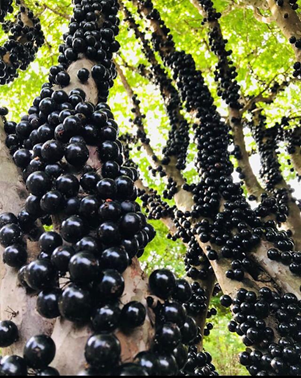Aplicación exógena del ácido giberélico en el desarrollo y la calidad de las frutas jabuticaba

Resumen
Jabuticaba representa una de las especies nativas de explotación industrial ascendente debido a sus características organolépticas y funcionales, lo que la hace atractiva para la producción de alimentos y productos farmacéuticos. Sin embargo, la composición de las frutas no es favorable para el procesamiento, ya que las semillas constituyen gran parte de su composición. El uso de técnicas ya establecidas para otros cultivos debe estudiarse para mejorar las características de uso industrial. Por lo tanto, el objetivo de este trabajo fue evaluar el desarrollo y la calidad organoléptica de la jabuticaba, en función de la aplicación exógena de ácido giberélico en el tallo de las plantas en tres etapas reproductivas. Para esto, los tratamientos consistieron en cuatro concentraciones de ácido giberélico (0, 50, 100 y 200 mg L-1) aplicadas a los tallos de las plantas de jabuticaba en tres etapas fenológicas reproductivas (botones florales, antesis y post-floración). Se adoptó un diseño de bloques completos al azar en un esquema factorial (4×3) con seis repeticiones. Se observó que la aplicación durante la antesis y después de la floración dio como resultado valores más bajos de masa de semillas, número de semillas y mayor rendimiento de pulpa, en promedio 23.08, 22.97 y 20.87%, respectivamente. Sobre el tratamiento de los botones florales el aumento de las concentraciones de ácido giberélico también dio como resultado un aumento del rendimiento de la pulpa hasta un máximo del 12,58%. Por lo tanto, se concluyó que la aplicación de concentraciones crecientes de ácido giberélico, hasta 200 mg L-1, mejora el rendimiento de la pulpa, sin alterar las características organolépticas de los frutos de jabuticaba y que la aplicación en post-floración o antesis proporciona una mayor calidad para su industrialización.
Palabras clave
Plinia spp., Especies nativas, Regulador de crecimiento, Fisiología vegetal, Fructificación subtropical, Desarrollo celular
Citas
Cardoso, M.R.D., F.F.N. Marcuzzo, and J.R. Barros. 2014. Classificação climática de Köppen-Geiger para o estado de Goiás e o Distrito Federal. Acta Geogr. 8(16), 40-55.
Ferreira, D.F. 2014. Sisvar: A guide for its Bootstrap procedures in multiple comparisons. Ciênc. Agrotec. 38(2), 109-112. Doi: 10.1590/S1413-70542014000200001
Kosera Neto, C., A.H. Porto, M.D. Silva, J.C. Radaelli, and A. Wagner Júnior. 2018. Reproductive and vegetative behavior of hybrid jabuticaba tree under flowering induction. Pesqui. Agropecu. Trop. 48(2), 118-125. Doi: 10.1590/1983-40632018v4851911
Pandolfini, T. 2009. Seedless fruit production by hormonal regulation of fruit set. Nutrients 1(2), 168-177. Doi: 10.3390/nu1020168
Pereira, M.C.T., J.H. Crane, S. Nietsche, W. Montas, and M.A. Santos. 2014. Reguladores de crescimento na frutificação efetiva e qualidade de frutos partenocárpicos de atemoia 'Gefner'. Pesq. Agropec. Bras. 49(4), 281-289. Doi: 10.1590/S0100-204X2014000400006
Pires, E.J.P. and R.V. Botelho. 2001. Uso de reguladores vegetais na cultura da videira. p. 129. In: Libro de resúmenes, Simpósio Brasileiro sobre Uvas de Mesa. Fundação de Amparo à Pesquisa do Estado de São Paulo, Ilha Solteira, Brazil.
Semensato, L.R., E.P.V. Vendruscolo, A. Seleguini, P.A. Batista Filho, E.C.M. Silva, and T.P. Silva. 2020. Fenologia, produtividade e qualidade de frutos de jabuticabeiras de diferentes idades das plantas. Iheringia Sér. Bot. 75, e2020013. Doi: 10.21826/2446-82312020v75e2020013
Sezerino, A.A. and A.I. Orth. 2015. Pollination of the portuguese pear in Bom Retiro-SC, Brazil. Rev. Bras. Frutic. 37(4), 943-951. Doi: 10.1590/0100-2945-209/14
Silva, K.K.A., E.O. Ono, M.A.C. Mouco, G.J. Nogueira, R.J.M. Souza, N.C. Silva, and R.D.C.B. Silva. 2017. Uniconazole no florescimento e produção da mangueira (Mangifera indica L.) cv. Palmer. Magistra 26(4), 505-514.
Soares, J., A. Silva, and J. Alexandre. 2001. O livro da pera rocha. Associação Nacional de Produtores de Pera Rocha, Cadaval, Brazil.
Taiz, L., E. Zeiger, I.M. Møller, and A. Murphy. 2017. Plant physiology. 6th ed. Sinauer Associates Publishers, Sunderland, MA.
Tecchio, M.A., M.F. Moura, J.L. Hernandes, E.J. Paioli-Pires, M.M. Terra, and S. Leonel. 2009. Efeito do ácido giberélico nas características ampelométricas dos cachos de uva ‘A Dona’e ‘Marte’. Sci. Agrar. 10(4), 297-304. Doi: 10.5380/rsa.v10i4.14800
Tofanelli, M.B.D., J.E. Amaya-Robles, J.D. Rodrigues, and E.O. Ono. 2003. Ácido giberélico na produção de frutos partenocárpicos de pimenta. Hortic. Bras. 21(1), 116-118. Doi: 10.1590/S0102-05362003000100024
Vieira, C.R.Y.I., E.J.P. Pires, M.M. Terra, M.A. Tecchio, and R.V. Botelho. 2008a. Efeitos do ácido giberélico e do thidiazuron sobre as características dos frutos e do mosto da uva ‘Niagara Rosada’. Rev. Bras. Frutic. 30(1), 12-19. Doi: 10.1590/S0100-29452008000100005
Vieira, C.R.Y.I., E.J.P. Pires, M.M. Terra, M.A. Tecchio, and M.D.C. Vieira. 2008b. Reguladores vegetais influenciando número e tamanho de células das bagas da uva 'Niagara Rosada'. Rev. Bras. Frutic. 30(1), 25-30. Doi: 10.1590/S0100-29452008000100007
Vilela, R.C.F., J. Assis, L. Nóbrega Filho, and B.F. Viana. 2012. Sistema reprodutivo e diversidade genética de quatro espécies de Myrciaria (Myrtaceae, Jabuticabeiras). Acta Bot. Bras. 26(4), 727-734. Doi: 10.1590/S0102-33062012000400002
